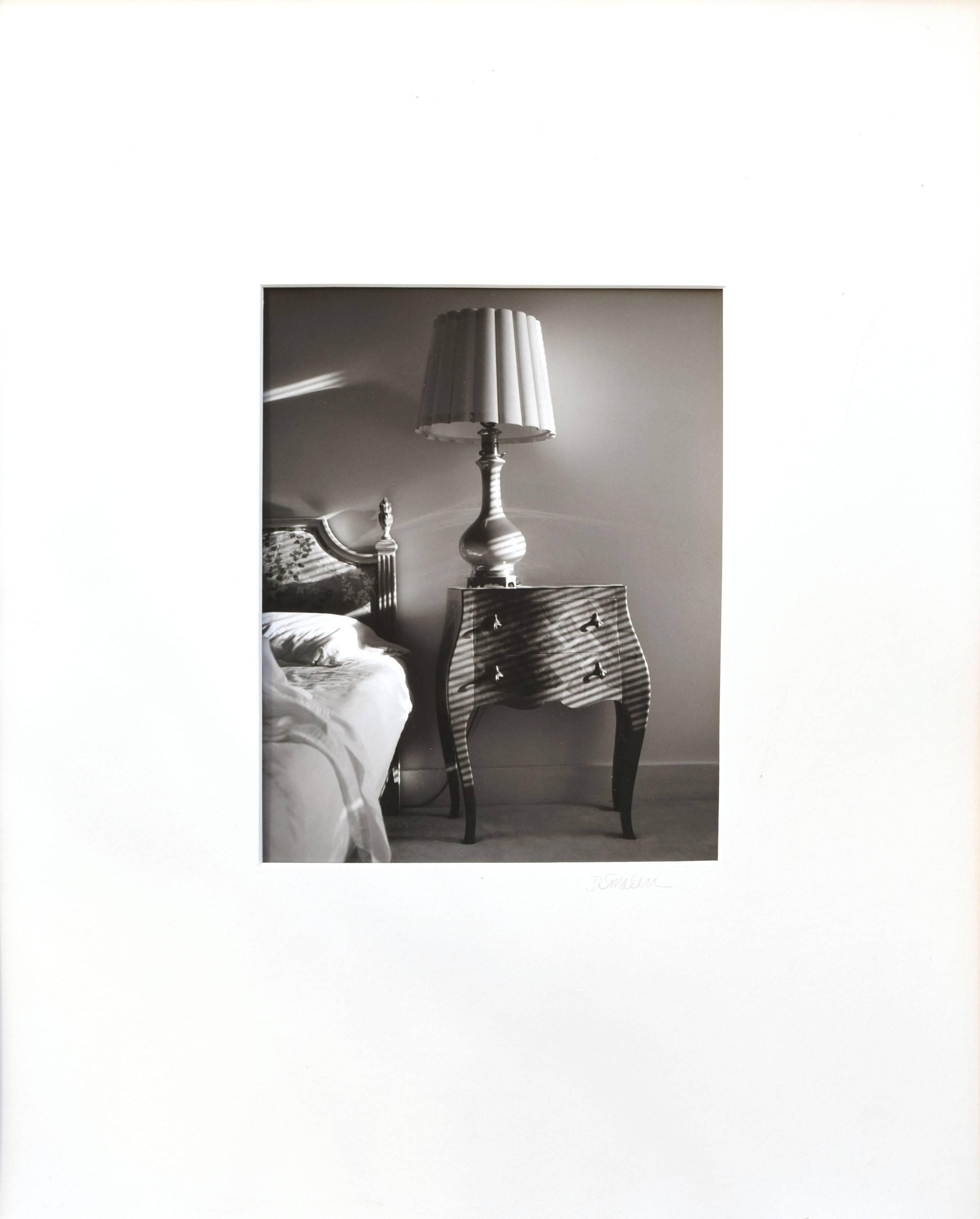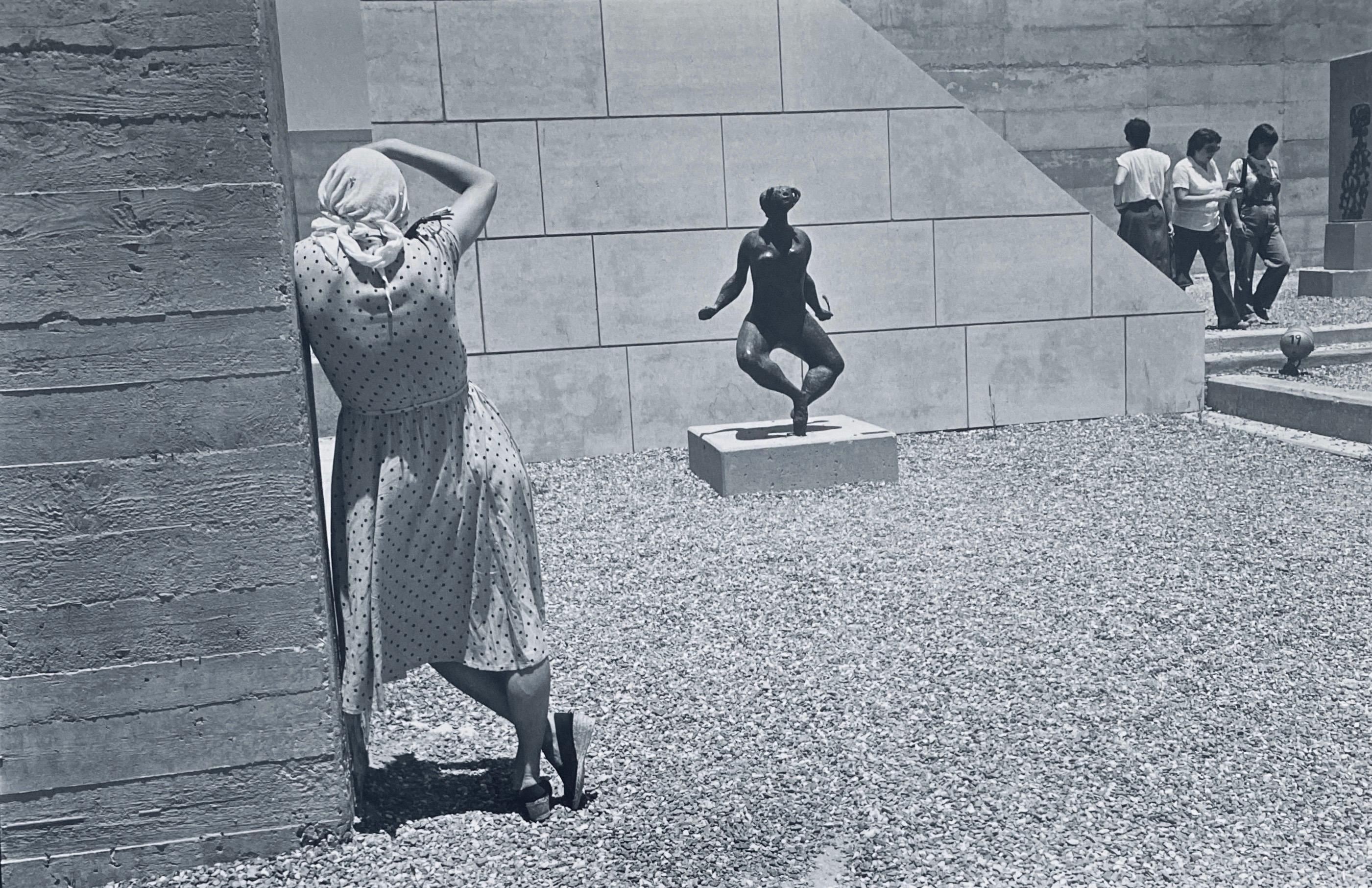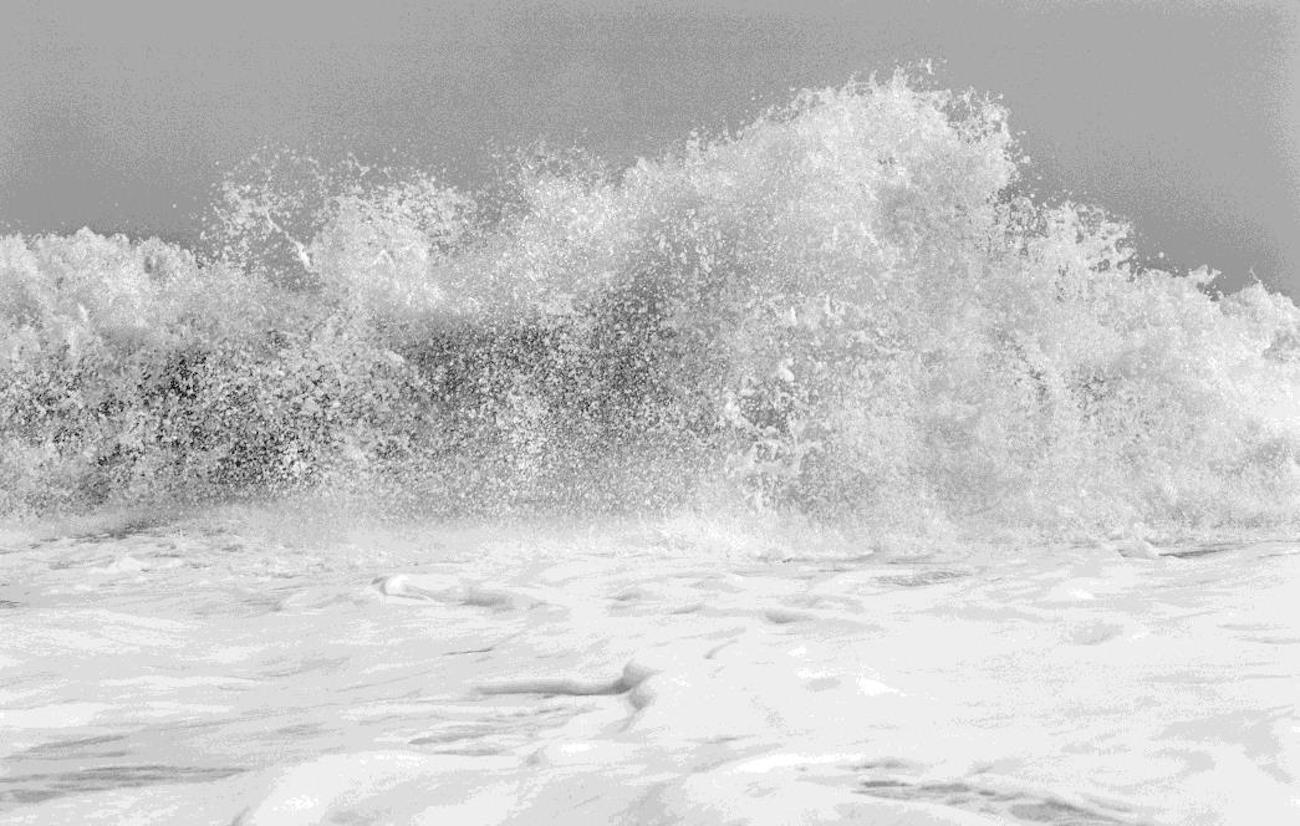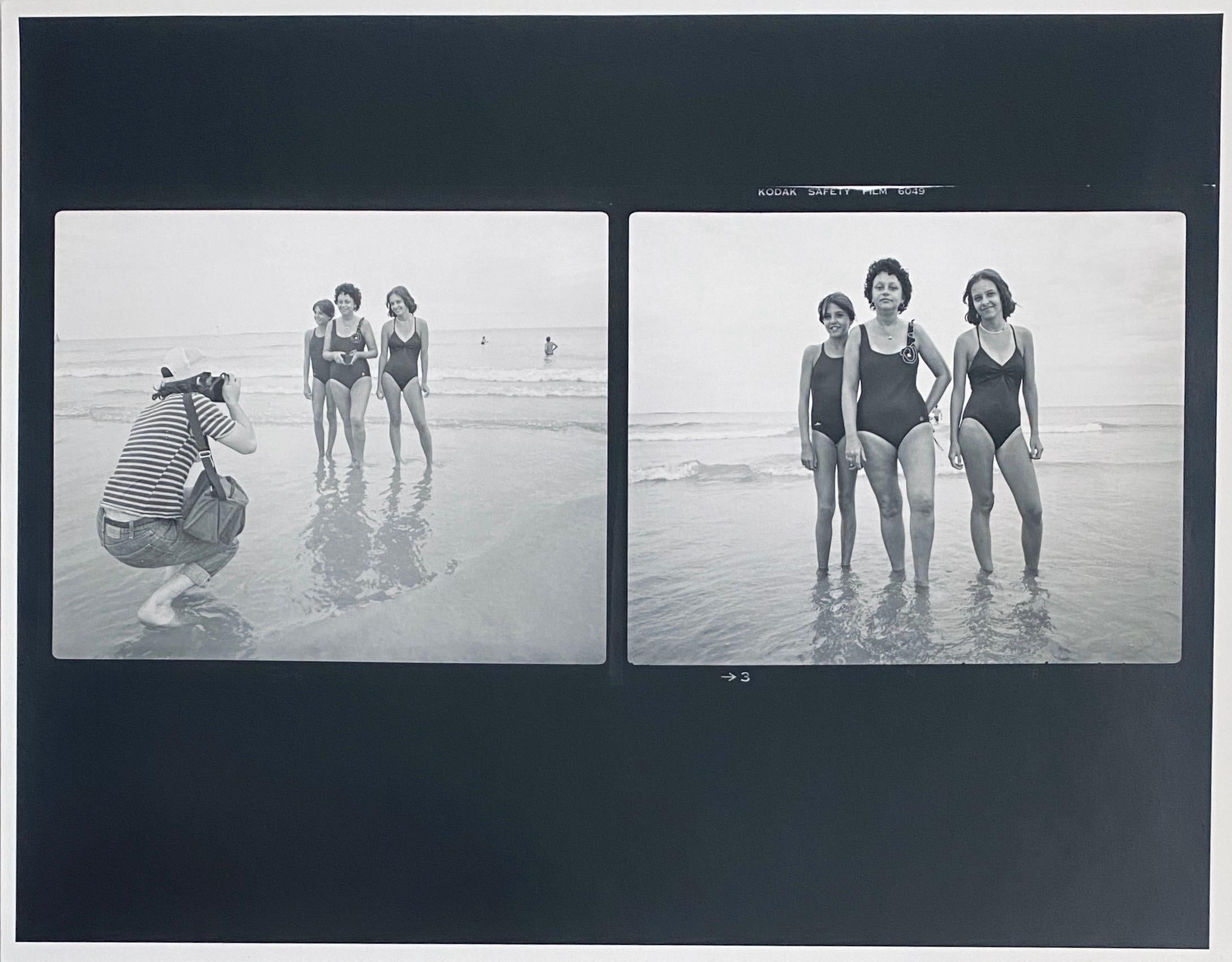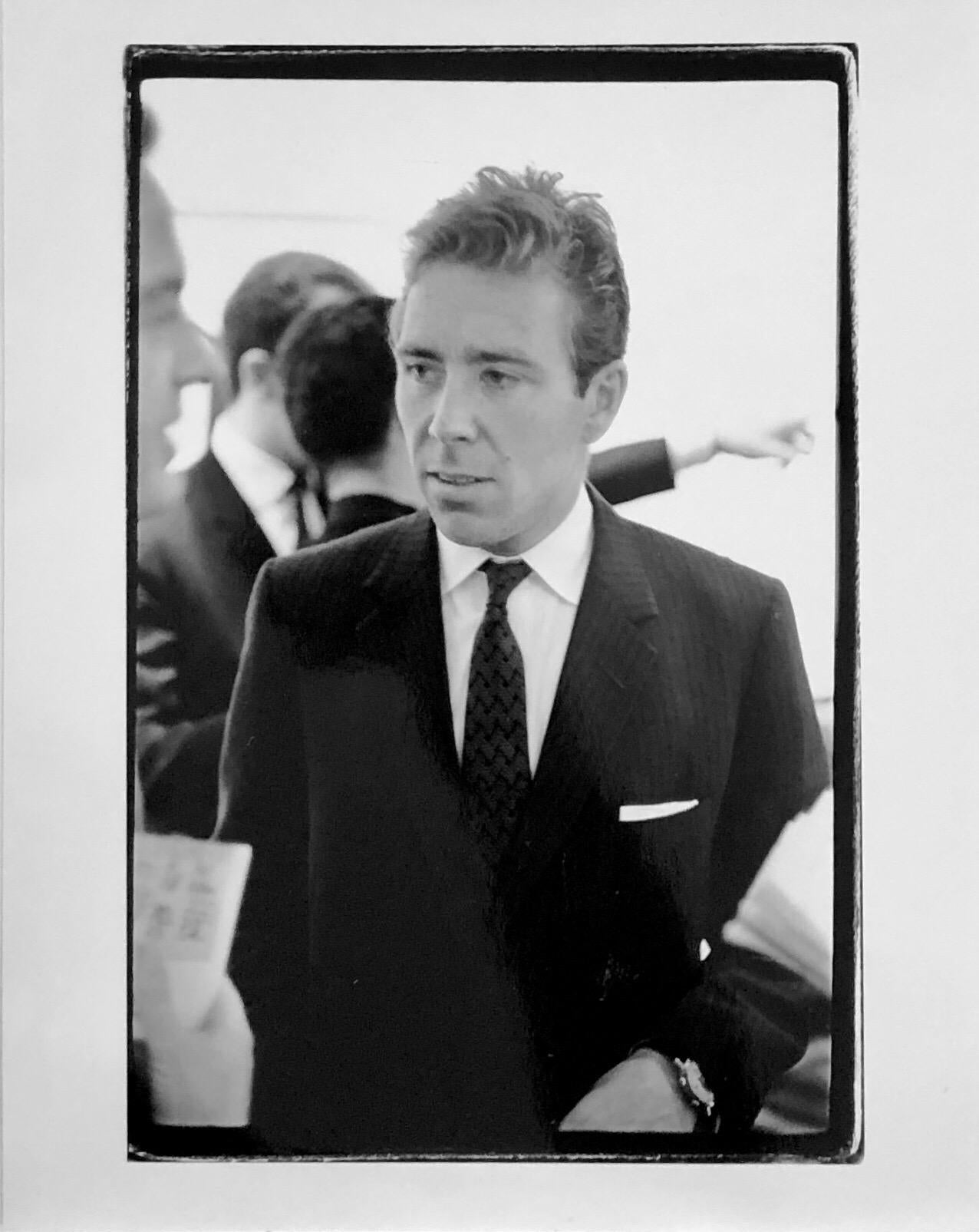Items Similar to Waterski Jumper
Want more images or videos?
Request additional images or videos from the seller
1 of 9
WeegeeWaterski Jumper1950
1950
About the Item
Arthur Felling, better known as Weegee (1899-1968) is America's premiere photojournalist and one of the last century's most influential photographers.
He would become famous, beyond New York and news circles, after the publication of his photo books Naked City (1945) and Weegee's People (1946).
Weegee's images of New York City crime, disaster, and tragedy are frequently iconic and highly influential. Less well-known, however, is the work he focused on during the last twenty years of his life: known as the 'distortions' period. In the late 1940s, Weegee began experimenting with photographic manipulation both in the darkroom and using an array of filters, many of which were his own invention, on his camera.
Weegee created distortions of a wide range of subjects; celebrities, architecture, circus life, and nudes. Of course, one of the overarching themes of his work was the idea of spectacle.
In this evocative distortion, the photograph has been split directly down the center and reflected. It's impossible to tell which side of the image is the original and which side is the reflection.
The dynamic image features two waterskiers, one suspended in the air mid-jump, while the other touches down, prompting a spray of water upon impact. This brief moment of daring motion is distorted into an almost perfectly symmetrical image, with limbs and perspective lines converging at the center for an almost Op Art effect.
Weegee’s photography can be found in scores of museums and private collections worldwide: the J. Paul Getty Museum, Los Angeles; Museum of Modern Art, New York; San Francisco Museum of Modern Art; Museum of Modern Art, Oxford; Museum of Contemporary Art, Los Angeles; International Center of Photography, New York and more.
Questions about this piece? Contact us.
Untitled "Waterski Jumper"
USA, 1950
Gelatin silver print
Stamped verso
8.25"H 4.75"W (work)
14.5"H 10.5"W (framed)
Framed with museum glass
Detailed condition report by request. Overall very good condition
- Creator:Weegee (1899-1968, American)
- Creation Year:1950
- Dimensions:Height: 8.25 in (20.96 cm)Width: 4.75 in (12.07 cm)
- Medium:
- Movement & Style:
- Period:
- Condition:Very good condition.
- Gallery Location:Toronto, CA
- Reference Number:
Weegee
Arthur Fellig, who later assumed the pseudonym Weegee, was a photographer and photojournalist, best known for his gritty black-and-white imagery taken on the streets of New York City. Born in 1899 in what is now the Ukraine, he arrived in the United States with his family in 1909, and settled in Brooklyn. After working in a variety of photography-related jobs, he struck out on his own at the age of 35 as a self-taught freelance photographer, selling his work to publications like the Herald Tribune, the Daily News, the Post, and the Sun. Weegee worked mostly at night, usually around Manhattan Police Headquarters. He was the only freelancer in New York to obtain permission to install a police radio in his car. As a result, he was often the first to arrive at the scene of the many crimes he photographed, often before the police themselves had responded. Moreover, he traveled with a makeshift darkroom in the trunk of his car, so he could produce, and then sell, his images faster than his competitors. But crime was not his only subject. He also photographed socialites at high-society events, circus performers, street life, tenement housing conditions, and many other facets of New York life. For a number of years he traveled extensively in Europe, and worked for the London Daily Mirror. He later returned to New York City, where he died in 1968. Th Museum of Modern Art began collecting his work in 1943, and featured it in several exhibitions. His work was also shown at the New York Photo League, and the International Center of Photography hosted a retrospective of his work in 1998. He has been featured in exhibitions at European venues such as the Kunsthalle Vienna, Austria's Flatz Museum, and the Multimedia Art Museum in Moscow. Several monographs of his work have been published.
About the Seller
4.8
Gold Seller
These expertly vetted sellers are highly rated and consistently exceed customer expectations.
Established in 2009
1stDibs seller since 2015
177 sales on 1stDibs
Typical response time: 1 hour
- ShippingRetrieving quote...Ships From: Toronto, Canada
- Return PolicyA return for this item may be initiated within 3 days of delivery.
More From This SellerView All
- Weegee "A Trip to Mars"By WeegeeLocated in Toronto, OntarioWhile many first associate Weegee (aka Arthur Fellig) with New York City crime scenes, perhaps a broader and more consistent theme is that of spectacle and/or urban entertainment. The origins of his nick-name and reputation date back to the 1930s when he became the first New York City press photographer to obtain permission to install a police radio in his car. Following the city's first responders and documenting their duties, Weegee had unprecedented access to New York’s fires, crimes, debaucheries and of course, murders. During the first decade of his career these unflinching urban tragedy or crime images paid Weegee's bills, but as he became more financially independent he was more inspired to pursue photographs on his own agenda. While his oeuvre is vast, Weegee was especially drawn to entertainment: nightlife, circuses, the theatre, showgirls, city thrills, the cinema etc. Some of Weegee's most dynamic and tender (and under-appreciated!) images are related to simply having fun (in a crowd). He was not confined to one neighbourhood or demographic. He captured action, faces and events from Coney Island to the Bowery and Greenwich Village, to Times Square and Harlem. In “A Trip To Mars,” Weegee depicts a multi-generational group crowding around a large telescope...Category
1940s American Modern Black and White Photography
MaterialsSilver Gelatin
- Groom Kissing His BrideBy Diane ArbusLocated in Toronto, OntarioDiane Arbus (1923-1971) is one of the most influential and daring photographers of the 20th century. Arbus is best known for her unique form of documentary portraiture. She explored the uncanny, the marginalized, and the idiosyncratic characters who defied mid-century conformity. Her work has influenced some of the most renowned photographers of our time including Nan Goldin. While her career launched in the fashion world, it was years after quitting commercial photography (circa 1956) that she found her voice as an artist. With camera in hand, she followed her fascination with the eccentric individuals and oddities of New York City. Ultimately rejecting her affluent, sheltered upbringing and the mainstream fashion industry to create her own definitions of beauty. Arbus’ portraits were considered incredibly provocative for their bold representations of sexuality, chaos, and grit. She fully immersed herself within the queer and alternative communities she documented, engaged with a curious balance of mystery and homage. Shot in 1966, "Groom Kissing His Bride" is a prime example of her uncanny ability to capture even the most traditional moments (a wedding) through a lens of surrealism. Love and tension confront each other as the groom kisses the bride with an attacking passion. Her likeness disappears behind his embrace and their newlywed bodies merge together. This work also contains Arbus’ visual trademarks – a black and white palette, a square crop, and a hard flash that flattens the aesthetic wonderland of New York. Today, Arbus' work is celebrated in many major museum collections including the Art Gallery of Ontario, Art Institute of Chicago, National Museum of Modern Art (Tokyo), and Centre Pompidou (Paris). "Groom Kissing his Bride, NYC" USA, 1966 Gelatin-silver print Printed by Neil Selkirk Stamped 'A Diane Arbus photograph...Category
1960s American Modern Black and White Photography
MaterialsSilver Gelatin
- GardeniaBy Robert MapplethorpeLocated in Toronto, OntarioRobert Mapplethorpe earned his place in the canon from his incredible output of images that ranged from beautiful to brutal. Mapplethorpe was one of the key artists who helped elevate photography from image-making to fine art. Mapplethorpe (1946-1989) fearlessly depicted the body (his own, friends' and lovers') in a way that positioned his work in line with masters such as Reubens, Courbet and Eadweard Muybridge to mention a few. Despite the sometimes shocking content of his work, Mapplethorpe's photographs possess a formalist quality with their undeniable beauty and strict compositions. From 1978-1981, Mapplethorpe created thirty-nine black and white photographs that make up his acclaimed XYZ Portfolios. While each portfolio is a distinct exploration of Mapplethorpe's signature subject matter, when combined, XYZ Portfolios serves as a definitive and in-depth representation of his mature and most sought-after, period. (Of the portfolios, X explores homosexuality and sadomasochism; Y features floral still life; while Z showcases portraits of Black men) Click here to see a portrait from the Z portfolio. In 2012, the XYZ Portfolios were shown in an exhibition at LACMA and presented in three rows (X on top, followed by Y in the middle, and Z below) as Mapplethorpe had envisioned them in 1989. "Gardenia" is one of thirteen images from the Y Portfolio, featuring a fragrant and graphic flower. Shot overhead, this tranquil image captures a delicate flower subtly floating in a dark, contrasting bowl. Aside from the flower's shadow below, the still water is nearly inconspicuous, contributing to the air of grace and elegance that this piece evokes. While the depiction is straightforward, Mapplethorpe's contrasts lead to a more ambiguous image; is this actually a flower or some alien specimen being examined? This powerful black and white image is a prime example of Mapplethorpe's work, highlighting his studio-centric practice as well as his refined and meticulous printing. This is a rare opportunity to acquire an iconic work by one of the most influential photographers of the 20th Century. Caviar20 is proud to be offering this monumental and important piece. "Gardenia" USA, 1978 Gelatin silver print Signed in ink by Michael Ward Stout and credited and dated on photographer's estate stamp, mount verso. 13.25"H 12.75"W (image) 16.75"H 16"W (framed) Very good condition Provenance: Xavier Hufkens...Category
1970s American Modern Black and White Photography
MaterialsSilver Gelatin
- Weegee "Distortion: Stripes"By WeegeeLocated in Toronto, OntarioInnovative, provocative, inimitable - these are just a few of the words to describe America's boldest photographer. Arthur Fellig, better known as Weegee (1899-1968) was a ground-breaking, successful (and notorious) photojournalist. His images shot on the streets of New York City are iconic and influential. In the 1930s he became the first New York City press photographer to obtain permission to install a police radio in his car. This allowed him to follow the city's first responders and to document their duties; responding to fire, crime, debauchery and of course, murder. By the early 1940s Weegee was experiencing fatigue with crime reportage. Ironically, this was also the point when he finally began experiencing professional validation and acclaim, to the point of being a minor celebrity. Notably in 1941 he was included in The MoMA's seminal "50 Photographs by 50 Photographers" (curated by Edward Steichen). The museum would also acquire five Weegee photographs...Category
1940s American Modern Black and White Photography
MaterialsSilver Gelatin
- Weegee "Sailor and Girl Kissing"By WeegeeLocated in Toronto, OntarioWeegee (1899-1968) was equally fascinated and inspired by cinema and all of its tangents, from Hollywood movie stars to ordinary civilians going to the movies. While Weegee is typically associated with crime/disaster images, the broad theme of "entertainment" is a major component of his oeuvre. An interesting and provocative sub-genre of his cinema-related work are his images of couples (often heavy-petting) in movie theatres. Recent scholarship has established that many of Weegee's supposed clandestine images were actually staged or arranged with friends or co-operative strangers. Nevertheless, Weegee created these photographs in the dark with an array of clever techniques including infrared film, filtered flashbulb and triangular prism lens. Employed in shots such as this one, the prism lens would allow the artist to “see around corners,” useful at times when his subjects were in compromising locations. These images of kissing couples, Weegee wrote in 1959, were “his best seller, year in and year out.” "Sailor and GIrl at the Movies...Category
1940s American Modern Black and White Photography
MaterialsSilver Gelatin
- One PistolBy Andy WarholLocated in Toronto, OntarioAndy Warhol began using the big-shot Polaroid camera in 1971 and continued using it religiously until his death in 1987. Despite the camera being discontinued in 1973, he continued t...Category
1980s American Modern Black and White Photography
MaterialsPolaroid
You May Also Like
- Terry O'Neill 'Alice Cooper and Family, Los Angeles'By Terry O'NeillLocated in New York, NYAlice Cooper, Los Angeles, 1974, Printed Later Silver gelatin print 40 x 40 inches estate stamped and numbered edition of 50 with certificate of authenticity Terry O'Neill, Alice ...Category
1970s American Modern Black and White Photography
MaterialsSilver Gelatin
- Table with Lamp - Black & White Bedroom Interior PhotographLocated in Soquel, CASilver Photographic print of a bedside table and lamp by D. Smalen. Signed lower Right on mat "D. Smalen." Circa 1980-90. Size 10"H x 8"W , Sight, 9"H x 7.25"W, Mat, 16"H x 20"W.Category
1980s American Modern Black and White Photography
MaterialsPhotographic Paper, Silver Gelatin
- Vintage Silver Gelatin Print Photo Israel Museum Sculpture Jerusalem PhotographLocated in Surfside, FLSusan Hacker -Israel Museum, Sculpture Garden, Jerusalem, Israel, 1979 Silver Gelatin black/white photograph, printed in 1983, hand signed, titled (Jerusalem) and noted. There is no edition size stated Location (Jerusalem), shoot date (1979) and photo print date (1983) and signature in pencil on the bottom back of the photograph. This is of the sculpture Woman skipping rope by Luciano Minguzzi located in the Isamu Noguchi designed sculpture garden at the Israel Museum Image size: 22 x 33 cm Paper size: 28 x 35.5 cm Susan Hacker (1949) is an American photographer and author. She developed and expanded the photography department at Webster University in St. Louis. Her work is in the possession of at least 25 major museums and libraries around the world. There are also many books and publications about her. Has always experimented with many photographic techniques. Hacker is recognized as an innovator of the modern photography art. Susan Hacker Stang (born Susan Hacker, October 19, 1949) is an American photographer, author, and educator. Stang served on the faculty of communications at Webster University in St. Louis from 1974 through 2015 and now holds the title Professor Emeritus. She helped found and build the respected photography program there, heading it for most of her tenure at the university. Her work has been collected by more than 25 major museums and libraries around the world and appears in half a dozen books and numerous magazines. Much of her photography involves the innovative use of alternative cameras, formats, techniques, and media, as evidenced by her two books Encountering Florence (featuring subtly surreal black and white prints of the Italian city using 8 x 10 Polaroid emulsion transfers) and Kodachrome – End of the Run: Photographs from the Final Batches (which chronicles a six-month university photography project in which students and staff would shoot more than 100 roles of rare Kodachrome film for processing on the last day of operations by the world's last remaining Kodachrome processing lab.) In 2016, she published a book of photographs, reAPPEARANCES, which is a sequence of fifty-two photographs made with a digital toy camera (the JOCO VX5). The volume purports to take the viewer on a visual journey through the uncanny coherence of the look of the world, according to Stang's introductory essay. Stang majored in photography at the Rhode Island School of Design, where she earned both a BFA (1971) and MFA (1974), and studied under photographers Harry Callahan and Aaron Siskind. In 1971 she moved to London where she worked as a photographer for the British fashion magazine NOVA (published 1965–1975). She joined the faculty of Webster University in St. Louis in 1974, where she helped found and build the photographic studies program in the School of Communications. In Jerusalem in 1979 she was Artist-In-Residence at the Bezalel Academy of Arts and Design. In recent years, in addition to her work as head of the Webster University photography program and professor of communications, she has taught summer photography workshops in Florence, Italy, both at the Santa Reparata International School of Art (SRISA) and The Darkroom. She taught at Webster for 41 years and earned the Kemper Award for Excellence in Teaching. Stang's photography characteristically employs alternative cameras (such as the Olympus Pen-FT half-frame camera, the Kodak Brownie, and the Holga), or alternative formats (such as Polaroid emulsion transfers) and techniques. Her book of Polaroid emulsion transfers, Encountering Florence was published simultaneously in the U.S. and in Italy (under the title Firenze un Incontro) in 2007. Stang's use of the emulsion transfer process involves transferring the fragile, fabric-like emulsion layer of the photograph (bearing the image) to another surface, subtly transforming the original image in a variety of ways. The results were described in Photo Review as giving Stang's portraits of Florence's buildings, streets, statuary, and gardens "a delicate, draping quality ... reminiscent of the fabrics draped on the ancient statues within the images". An Italian reviewer observed that the photographic process presents "a city not previously seen and perhaps a little disquieting". The book's bi-lingual text in English and Italian was selected and edited by Stang and by Andrea Burzi and Susanna Sarti, both of Florence, to present accompanying word-portraits from authors in their own encounters with the city. A portfolio of Stang's work for the book is held by the Rare Books Collection of the Biblioteca Nazionale Centrale Firenze. In 2010–11, Stang led the Webster University photography program in a six-month-long focus on the color reproduction qualities of Kodachrome film (long revered by professional and amateur photographer for its true, lush color rendition qualities) to mark the permanent discontinuing of the film's production by Kodak. The project ultimately turned into a book documenting the final demise of the medium, and the last day of Kodachrome production anywhere in the world (at Dwayne's Photo in Parsons, Kansas, on January 18, 2011). The last days of processing were covered by The New York Times, National Geographic, and network television. Edited by Stang and fellow photographer Bill Barrett, Kodachrome: End of the Run presents a selection of four-score Kodachrome images shot on more than 100 roles of the film by Webster University students, faculty, and staff over a five-month period and processed by Dwayne's in the final hours as the last processing chemicals ran out. The book includes essays by Stang, Time Magazine worldwide pictures editor Arnold Drapkin, and Dwayne's Photo vice president Grant...Category
1970s American Modern Black and White Photography
MaterialsSilver Gelatin, Photographic Paper
- Wave 2 (After the Storm)By Michael DweckLocated in Sag Harbor, NYMichael Dweck is an American photographer known for his Montauk beach scenes.Category
2010s American Modern Black and White Photography
MaterialsSilver Gelatin
- Vintage Silver Gelatin Photograph Print, Girls on a Beach Photo, Two Man ShowLocated in Surfside, FLRichard Lebowitz, b. 1937, American, (RISD Faculty 1964-1995, Photography; Professor Emeritus) Tom Young, b. 1951, American, (RISD MFA 1977, Photography) TIT...Category
1980s American Modern Black and White Photography
MaterialsPhotographic Paper, Silver Gelatin
- Vintage Signed Silver Gelatin Photograph Dapper Lord Snowdon Photo Suit & TieBy Fred McDarrahLocated in Surfside, FLLord Snowdon Over a 50-year span, McDarrah documented the rise of the Beat Generation, the city’s postmodern art movement, its off-off-Broadway actors, troubadours, politicians, agi...Category
1960s American Modern Black and White Photography
MaterialsSilver Gelatin
Recently Viewed
View AllMore Ways To Browse
Los Angeles 1950
Crime Photographs
Jump Photo
Black And White Oxfords
Naked And Famous
Vintage Circus Books
White Jumper
Vintage Circus Photographs
Weegee Photograph
Vintage Circus Photography
Circus Glasses Vintage
Vintage Circus Photos
Arthur Fell
Used Waterskis
Vintage Waterski
Vintage Waterskis
Female Portraits Black White
Vintage Japanese Photos

